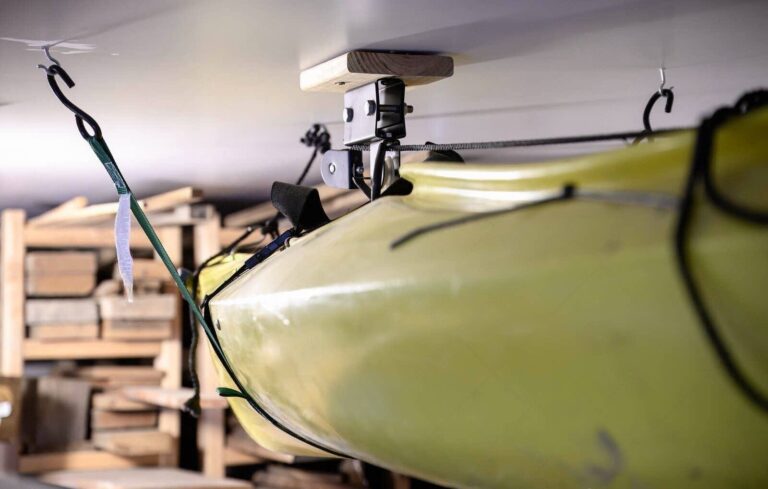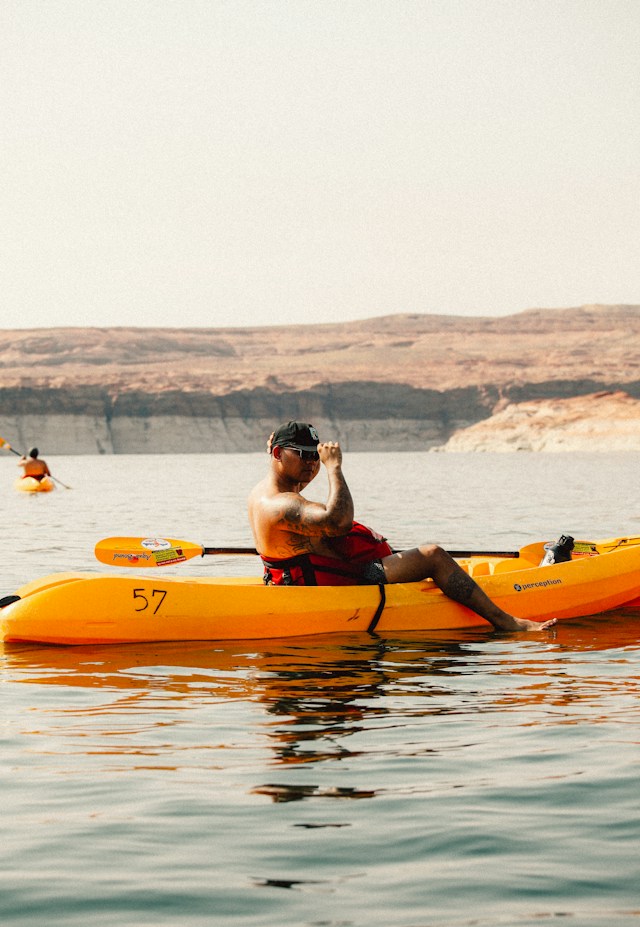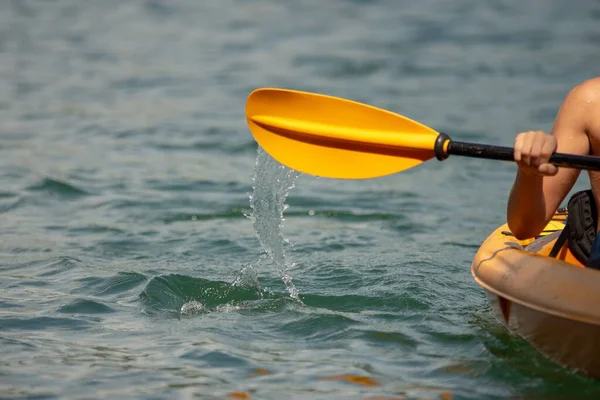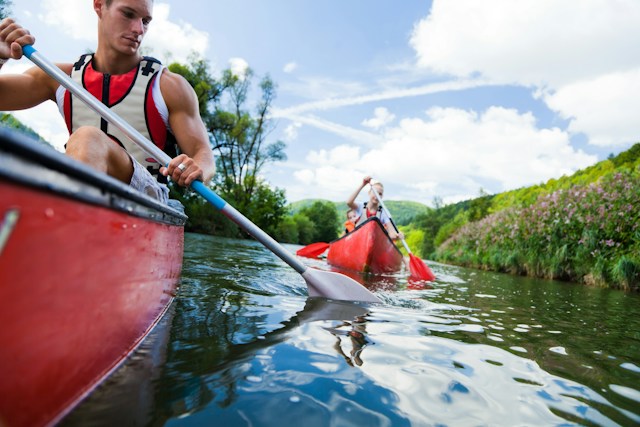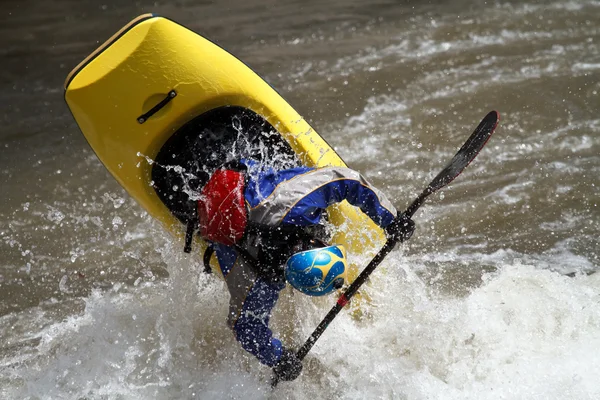Will You Get Wet While Kayaking? – A Friendly Guide
Are you excited to experience the thrill of kayaking and wondering if you’ll get wet during your adventure?
Well, the answer is yes, you most likely will get wet while kayaking! But don’t worry, getting wet is part of the fun!
Kayaking is a fantastic way to connect with nature and enjoy the outdoors. It’s a physical activity that requires you to paddle through water, which means you’re bound to get splashed.

However, the level of wetness depends on different factors that we’ll explore in detail.
In this article, we’ll provide you with all the information you need to know about staying dry while kayaking.
We’ll discuss the different factors that contribute to getting wet, the types of kayaks and paddles that can help keep you dry, proper paddling techniques, and much more.
By the end of this guide, you’ll be prepared to tackle the water and enjoy your kayaking adventure relatively dry.
So, let’s get started and answer the question – Will you get wet while kayaking? The answer is most likely yes, but don’t let that stop you.
Kayaking is an incredibly fun adventure that’s worth getting a little wet for.
- Why Will You Get Wet While Kayaking?
- Types of Kayaks and Their Impact on Dryness
- The Importance of the Right Paddle
- Mastering Paddling Technique
- The Influence of Weather Conditions
- How to Paddle a Kayak Without Getting Wet
- Exiting Your Kayak Gracefully
- Embracing the Joy of Getting Wet
- Conclusion
- Frequently Asked Questions
Why Will You Get Wet While Kayaking?
If you’ve ever wondered why you might get wet while kayaking, there are a few key factors to consider.
From the type of kayak you use to the weather conditions and your paddling technique, each element plays a role in determining whether you’ll stay dry or not.
The Type of Kayak
One of the biggest factors that determines how wet you get while kayaking is the type of kayak you use.
Sit-on-top kayaks are more likely to expose you to water splashes compared to sit-inside kayaks.
| Kayak Type | Wetness Level |
|---|---|
| Sit-on-top kayak | More likely to get wet |
| Sit-inside kayak | Less likely to get wet |
As you can see, choosing the right type of kayak can make a significant difference in keeping you dry during your kayaking adventure.
The Paddle You Use
The paddle you use can also impact how wet you get while kayaking. The length, blade shape, and material of the paddle can affect your paddling efficiency and minimize water splashes.
A longer paddle can help you keep your hands and upper body drier, while a wider blade can push more water and create more splashes.
Paddling Technique
Proper paddling technique is crucial for staying dry while kayaking. By learning how to paddle efficiently, using proper strokes and body movements, you can minimize water splashes.
For example, using a low-angle stroke can reduce the amount of water that’s pushed into the kayak and keep you drier.
Weather Conditions
The weather can also have a significant impact on how wet you get while kayaking.
Rain, wind, and choppy waters can increase the chances of water splashing into your kayak.
It’s important to plan your kayaking trips based on weather forecasts and dress appropriately for the conditions to stay as dry as possible.
So, to answer the question of why you might get wet while kayaking, there are several factors to consider.
The type of kayak, the paddle you use, your paddling technique, and the weather conditions all play a role in determining how much water you’ll be exposed to during your kayaking adventure.
By understanding these factors and taking steps to minimize water exposure, you can have a great kayaking experience that keeps you relatively dry.
Types of Kayaks and Their Impact on Dryness
When it comes to kayaking, choosing the right type of kayak can make a significant difference in how wet you get during your adventure.
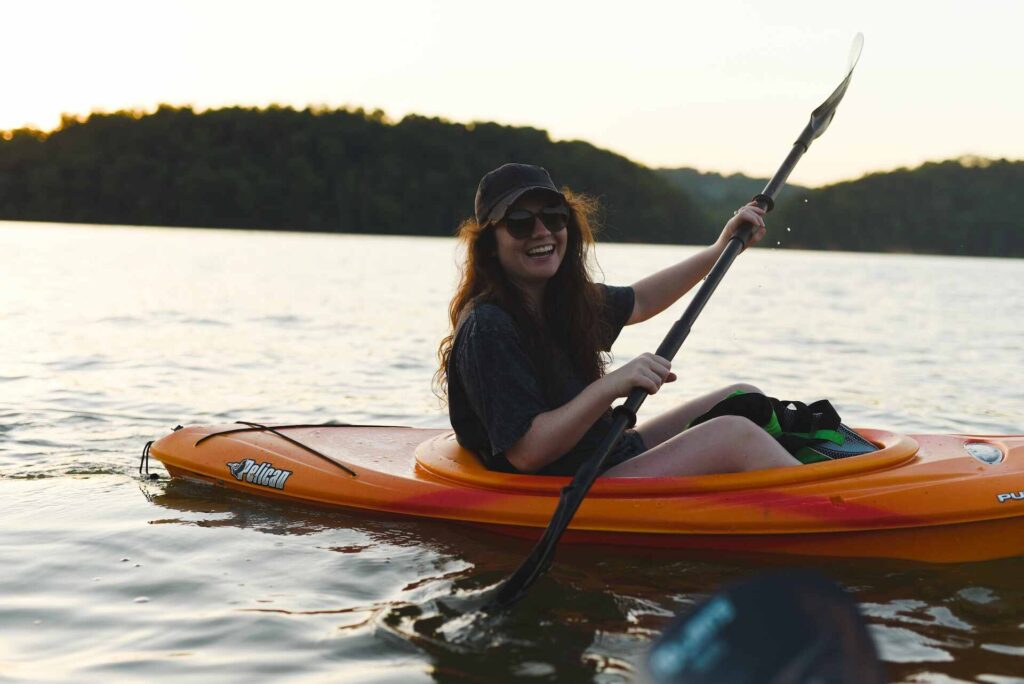
The two main types of kayaks are sit-inside kayaks and sit-on-top kayaks, each with its advantages and disadvantages.
Sit-Inside Kayaks
Sit-inside kayaks provide a more enclosed cockpit, which can offer better protection from water splashes.
With your legs and lower body tucked inside the kayak, you’re less exposed to waves and wind.
Sit-inside kayaks are suitable for colder waters because they can come equipped with a spray skirt, which keeps water from entering the cockpit. Additionally, Sit-inside kayaks can help you maintain a drier experience, especially on calmer waters.
Sit-On-Top Kayaks
Sit-on-top kayaks are more open and can provide a wetter kayaking experience. The design of these kayaks allows water splashes to come in more easily, increasing the chances of getting wet.
However, Sit-on-top kayaks are more comfortable and user-friendly than Sit-inside kayaks, making them ideal for recreational kayaking and warmer weather.
| Type of Kayak | Dryness |
|---|---|
| Sit-inside Kayak | Drier, especially on calmer waters |
| Sit-on-top Kayak | More exposed to water splashes |
The type of kayak you choose ultimately depends on your personal preference and the conditions of your paddling journey.
The Importance of the Right Paddle
When it comes to kayaking, the paddle you use is just as important as the kayak itself. Not having the right paddle can lead to inefficient paddling and more exposure to water, resulting in a wetter experience.
So, what factors should you consider when choosing the right paddle for a drier kayaking adventure?
The Paddle Length
The length of your paddle should be proportionate to your height and the width of your kayak.
Using a paddle that’s too long or too short can make paddling more difficult and increase the likelihood of water splashes.
A general rule of thumb for selecting the correct paddle length is to stand your paddle vertical on the ground with the blade facing downwards.
Your arms should be able to reach the top of the paddle without having to strain, and your elbows should form a 90-degree angle.
Related:
- CAN A KAYAK SINK? A COMPREHENSIVE GUIDE
- IMPACT OF WEATHER CONDITIONS ON KAYAK SAFETY
- HOW TO RECOVER FROM A KAYAK CAPSIZE AND RE-ENTER THE KAYAK?
- KAYAKING SAFETY: THE IMPORTANCE OF WEARING A LIFE JACKET
The Blade Shape
The shape of the paddle blade can have an impact on water splashes.
A wider blade will displace more water and create more splashing, while a narrower blade will cut through the water more efficiently, resulting in less water exposure.
The Material
The material of your paddle can also affect your overall kayaking experience.
Wooden paddles, for instance, are generally heavier and can cause more fatigue, making it harder to paddle efficiently.
Meanwhile, plastic and aluminum paddles are lightweight and easy to handle, allowing for a smoother paddling experience.
| Paddle Material | Pros | Cons |
|---|---|---|
| Wood | Durable, smooth grip | Heavy, causes fatigue |
| Plastic | Lightweight, affordable | Not as durable as other materials |
| Aluminum | Lightweight, durable | Can be slippery when wet |
Choosing the right paddle for your kayaking adventure can make all the difference when it comes to staying dry.
Remember to consider factors such as paddle length, blade shape, and material before hitting the water.
Mastering Paddling Technique
Proper paddling technique is key to staying dry while kayaking.
The better your technique, the less water you’ll have splashing around in your kayak. Here are some tips to help you paddle like a pro:
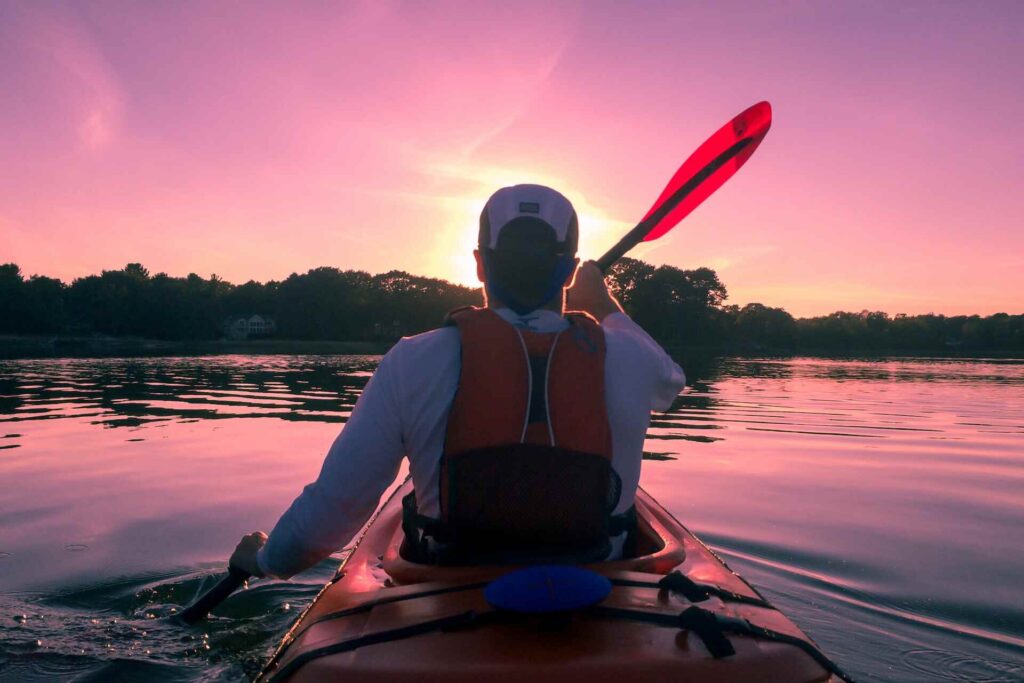
- Start with your upper body. Rotate your torso and use your core muscles to power your strokes. This will help you avoid using just your arms and getting tired too quickly.
- Keep your hands shoulder-width apart on the paddle. This will give you more leverage and control over your strokes.
- Use a light grip on the paddle. Gripping too tightly can cause tension in your arms, which can lead to fatigue.
- Place the paddle blade in the water as far forward as you can without reaching. This will give you the most power and keep the kayak moving forward more efficiently.
- Use long, smooth strokes to minimize splashing. Quick, jerky strokes will make more waves and increase your chances of getting wet.
- If you need to turn, use a sweep stroke by placing the paddle blade in the water and sweeping it out to the side of the kayak. This will help you turn smoothly without splashing too much.
Remember, practice makes perfect. The more you paddle, the better your technique will become, and the less water you’ll have splashing around in your kayak.
The Influence of Weather Conditions
Weather conditions play a significant role in determining whether you’ll get wet while kayaking.
The unpredictability of the weather can make it challenging to plan your kayaking trip perfectly, but it’s essential to stay informed about the forecast before hitting the water.
Understanding the Weather Forecast
The first step in planning your kayaking adventure is to check the weather forecast.
Look for forecasts that include detailed information about wind speed, temperatures, and precipitation, as these factors can impact your safety and comfort on the water.
If you’re planning a kayaking trip on a windy day, you’ll be more likely to experience water splashes.
Wind creates waves that can be challenging to paddle through, causing water to splash into your kayak.
Additionally, if the temperature is cold and you’re not wearing the right gear, you can become wet and cold, making it uncomfortable to paddle.
Tips for Kayaking in Wet Conditions
If you find yourself kayaking in wet conditions, it’s essential to take precautions to stay safe and comfortable.
Consider wearing waterproof clothing, such as a wetsuit or drysuit, to keep you dry and warm. You can also wear a spray skirt or use a kayak with a closed cockpit to minimize water splashes.
You should also choose equipment designed for wet conditions.
For example, a paddle with a drip guard can help prevent water from dripping onto you while you’re paddling. Alternatively, you can use a paddle leash to keep your paddle from falling into the water.
Stay Safe and Have Fun
Regardless of the weather conditions, kayaking can be a fun and rewarding experience.
By staying informed about the weather, planning your trip accordingly, and taking precautions to stay comfortable and safe, you’ll be able to enjoy your kayaking adventure, even if you get wet.
How to Paddle a Kayak Without Getting Wet
While getting wet is part of the kayaking experience, there are ways to minimize it and stay relatively dry. Follow these tips to paddle a kayak without getting drenched:
- Wear appropriate clothing – Choose quick-drying fabrics that wick moisture away from your skin. Avoid cotton, as it tends to hold onto water and can make you feel damp and uncomfortable.
- Adjust your seat position – Sit further back in your kayak to minimize water splashes. This is especially important when paddling in choppy waters.
- Use a drip ring – A drip ring is a small plastic ring that attaches to the paddle and helps reduce the amount of water that drips down the paddle onto your lap.
- Angle your paddle correctly – Hold your paddle at a low angle to reduce the amount of water splashes. Keep your top hand at shoulder level and use your torso to rotate, rather than your arms.
- Stay centered – Keep your weight centered over the kayak to maintain stability and minimize the chances of tipping over and getting wet.
By following these tips, you can have a comfortable and relatively dry kayaking adventure.
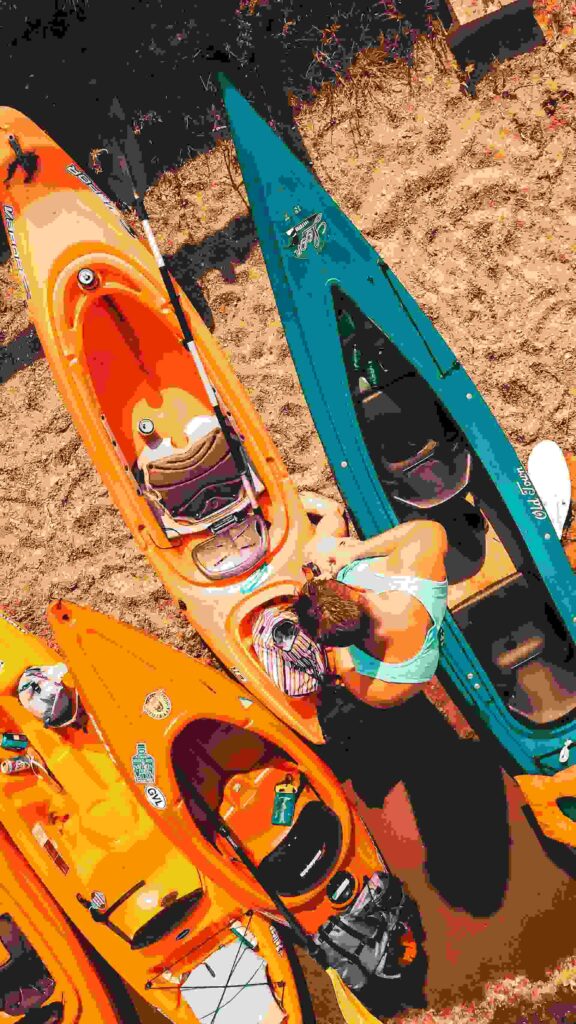
Remember, getting wet is part of the fun, so don’t be afraid to embrace the splash and enjoy the refreshing sensation of being on the water.
Exiting Your Kayak Gracefully
Exiting your kayak can be tricky, especially if you want to stay dry. But don’t worry, with a little practice, you can exit your kayak gracefully without getting wet.
Step 1: Approach the Shoreline
To exit your kayak without getting wet, paddle towards the shoreline until the water is shallow enough to step out.
Be cautious of any rocks or debris that might be in the way.
Step 2: Position Your Kayak
Once you’re in shallow water, position your kayak parallel to the shoreline and perpendicular to the waves.
This will make it easier to maintain your balance as you exit.
Step 3: Prepare to Exit
Take hold of the paddle with both hands, keeping it parallel and close to the kayak.
Place one hand on the shoreline for support and use the other hand to push yourself out of the kayak.
Step 4: Exit the Kayak
Slowly lift your leg out of the kayak while keeping your balance. Place your foot on the shoreline and stand up while maintaining your grip on the paddle.
Keep your eyes on the shoreline to maintain your balance.
Step 5: Store Your Gear
Once you’ve safely exited the kayak, store your gear, including the paddle, life jacket, and any other equipment.
You’re now ready to enjoy the rest of your day without being soaking wet!
Embracing the Joy of Getting Wet
While it’s possible to kayak without getting wet (see Section 7), it’s important to remember that the thrill of kayaking often comes from getting splashed, sprayed, and soaked.
Getting wet is part of the adventure, and it can be incredibly refreshing on a hot day. So, rather than trying to stay dry at all costs, why not embrace the joy of getting wet?
Kayaking is a unique opportunity to connect with nature and experience the water in a way that you can’t on land.
Feeling the splash of the water and the wind on your face can be invigorating, and it’s a reminder that you’re alive and present in the moment.
So, don’t be afraid to let go, have fun, and enjoy the journey.
In fact, some kayakers intentionally seek out rougher waters to increase the chances of getting wet.
If you’re feeling adventurous, you might want to try tackling some rapids or waves to experience the thrill and excitement of kayaking at its fullest potential.
Just remember to stay safe, wear appropriate gear (including a life jacket), and be mindful of your surroundings.
But with the right attitude and a willingness to embrace the water, getting wet can be one of the most enjoyable parts of kayaking.
Conclusion
Kayaking is a fantastic adventure that offers the thrill of getting wet while enjoying the beauty of nature.
By understanding the factors that contribute to getting wet, choosing the right equipment, and mastering proper techniques, you can have a great kayaking experience that keeps you relatively dry.
Although staying dry might be a priority for some kayakers, it’s important to remember that getting wet is part of the excitement and joy of kayaking.
There’s something exhilarating about paddling through water, feeling the spray on your face, and embracing the element that surrounds you.
Whether you’re navigating calm lakes or rushing rapids, kayaking offers an incredible opportunity to explore and connect with nature.
So, get ready to paddle, embrace the water, and enjoy the journey. Whether you end up dry or wet, you’re sure to have an unforgettable experience.
Frequently Asked Questions
How do you get in a kayak without getting wet?
Getting in and out of a kayak without getting wet can be a little tricky but with practice and proper technique, it is possible. Here’s a step-by-step guide to help you stay dry while getting into a kayak:
- Choose a stable location: Find a spot that provides stable footing, such as a dock, a sturdy shoreline, or a shallow area with a firm, non-slippery surface.
- Position the kayak: Ensure that the kayak is parallel to the shore, with the bow (front) facing the water.
- Prepare your paddle: Hold the paddle with the blade on the side closest to the kayak and use it as a stabilizer while entering the kayak.
- Kneel beside the kayak: Place one knee inside the cockpit while keeping the other knee on the ground outside the kayak. This will help maintain balance and stability.
- Lower yourself into the kayak: Sit on the back of the seat (near the cockpit opening) and carefully lower your body into the kayak, maintaining a low center of gravity.
- Slide into the cockpit: While stabilizing the kayak with the paddle, slide your knees, and then your feet, into the cockpit. Slowly shift your weight forward as you enter to maintain stability.
- Adjust your seating position: Sit upright and position your feet comfortably on the footrests or in the footwells. Ensure that you have proper posture and a good fit within the kayak.
When it comes to exiting the kayak without getting wet, simply reverse the steps mentioned above. Remember to take your time, be cautious, and maintain balance throughout the process.
It may also be helpful to use a kayak skirt or a towel to keep water from splashing into the cockpit.
Can you stay dry while kayaking?
If your kayak fills with water while you are out on the water, it’s essential to stay calm and follow these steps:
- Stay in the kayak: Do not panic and try to stay inside the kayak. It is easier to control and handle a water-filled kayak from within rather than attempting to swim to shore.
- Assess the situation: Determine the cause of the water filling the kayak. It could be from waves or a leak. If it’s due to a leak, try to locate and address it if possible.
- Secure loose items: Secure any loose gear or equipment inside the kayak to prevent them from floating away or causing further instability.
- Paddle to safety: If you are not far from shore and it’s safe to do so, begin paddling towards the nearest shore or a safe landing spot. Keep the kayak steady and maneuverable.
- Use bilge pump or bail water: If you have a bilge pump or a sponge, use them to remove water from the kayak while maintaining stability. Bail out as much water as possible to make the kayak easier to handle.
- Position yourself for self-rescue or assistance: If the kayak becomes too unstable or difficult to control, you can either perform a self-rescue technique, such as a kayak roll or re-enter and roll, or wait for assistance from another kayaker or rescue services.
Remember, it’s always a good practice to wear a personal flotation device (PFD) while kayaking, as it can help keep you afloat and provide additional safety in case of emergencies.
Additionally, regularly inspect and maintain your kayak to minimize the risk of leaks or other issues leading to water filling the kayak.
Why do you need wet shoes for kayaking?
Wearing wet shoes or water-specific footwear is important for kayaking for a few reasons:
- Protection: Wet shoes provide protection for your feet while kayaking. They shield your feet from sharp rocks, shells, or other potentially hazardous objects that you may encounter in the water or along the shoreline.
- Traction: Wet shoes are designed with materials that offer enhanced grip and traction on wet surfaces. This helps prevent slips and falls, especially when launching or exiting the kayak, maneuvering on slippery river banks, or walking on wet rocks.
- Comfort: Kayaking often involves getting wet, whether it’s from splashing water, paddle drips, or occasional capsizing. Wet shoes are designed to drain water efficiently and dry quickly, ensuring your feet remain comfortable throughout your kayaking adventure.
- Insulation: Wet shoes can provide insulation and help maintain warmth in colder water conditions. They act as a barrier between your feet and the chilly water, preventing direct contact and reducing heat loss.
- Hygiene: Using wet shoes also keeps your feet clean and protected from any potential contamination or bacterial exposure in the water, especially in less sanitary or unknown water conditions.
Wet shoes come in various styles, including water sandals, neoprene booties, or water socks, so choose a type that suits your preferences and the specific conditions you’ll be kayaking in.
Overall, having the right footwear enhances safety, comfort, and performance while kayaking.

